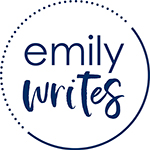Staring at a blank page can be the worst feeling in the world.
And writer’s block strikes more than just full-time writers! Anyone who writes emails, social media posts, or other correspondence on a regular basis knows what it feels like to be at a loss for words. As a small business owner, you wear a lot of hats – and writing is probably one of them, even if it’s not your strongest trait.
I’m not immune to this phenomenon. At least once a week, I start working on a project and find myself stuck. Here are six ways I get past the block and into the writing flow:
Tip 1: Copy and Paste
I write a lot of blogs and longer-form content. To get myself going, I’ll copy and paste any information that is relevant to the topic at hand.
For example, while writing a technical blog for a chemical engineering company recently, I copied all of the relevant website copy that related to the topic into my Google Doc. I also pasted the client’s email with the desired main points, my notes from a recent client call, and a social media post I wrote on the same topic.
With all the key facts and information in one place, it becomes much easier to start the project. And let’s face it, just having something on the page is motivating!
(An alternative to this method is to print off all the facts and information you need or use multiple computer screens so you have everything at your fingertips.)
Tip 2: Outline Key Points
This tip takes me back to middle school when they taught us to write essays with an introduction, key point, paragraph, key point, conclusion… Anyone else??
In all seriousness, outlining your writing really does help. You probably have a bunch of incoherent ideas swirling around your head when you start to write, so just jotting down a couple of key points or a rough outline will help settle your brain and give you a starting point.
Then, start expanding on each key point. It doesn’t matter which one you tackle first; you can always rearrange as you go.
For example, when I sit down to write 12 social media posts for a client, I outline what each of the 12 posts will cover with just a sentence or two. Then, I go back and write the post I’m the most excited about (or maybe it’s the one that’s the easiest to write!) and then tackle each post, one by one.
Breaking your writing into smaller, more manageable chunks helps you get over the writer’s block.
Tip 3: Write the Ending
The first few sentences of a project are often the hardest to write! We want to hook our readers right away.
I have a degree in journalism and worked at three newspapers throughout my college years. I have the “lede” structure – “who/what/where/when/why/how” in the first paragraph – burned into my brain. Condensing an entire article into a couple of sentences was always so intimidating to me, so I learned to work backward and start with the less important information and quotes, first, and work up to the lede.
Now, as a content marketer, I’m hyper-aware of the fact that my very first sentence of a social media post, the subject line of the email, or the blog introductory story are absolutely critical to hooking the reader. That’s why I often start at the end or somewhere in the middle, making the introduction easier to write once I’m in the flow.
Tip 4: Find Synonyms
If you’re really struggling to get words onto paper, even after trying the copy/paste method or the key point method, start with something even more basic: Synonyms.
For example, I recently wrote website content for a fellow solopreneur. I was struggling to get into the flow, so started looking up synonyms for some of the keywords I knew we were going to be using, such as “connection” and “brand” and “strategy.”
Yup, I just started compiling lists of words. It sounds crazy but it really does work! These individual words sparked ideas for entire sentences and new combinations of concepts, and I was quickly on a roll.
Tip 5: Write 10 Headlines
My journalism training taught me that the first headline written is rarely the one that will go to print. We’d often go through dozens of iterations before finding the perfect, attention-grabbing headline for an article.
In content marketing, the “headline” is the blog title, the email subject line, or the opening line of a social media post.
So, if you’re struggling to start writing, jot down 10 headlines. It doesn’t matter how great or terrible they are – you may not use any of them and a headline might not even be needed – but this exercise forces your brain to immerse in the topic at hand.
~
Overcoming writer’s block isn’t as simple as waving a magic wand, but I do find each of these techniques to be pretty darn effective. Please leave me a comment and let me know what you do to overcome writer’s block. I’d love to learn!

